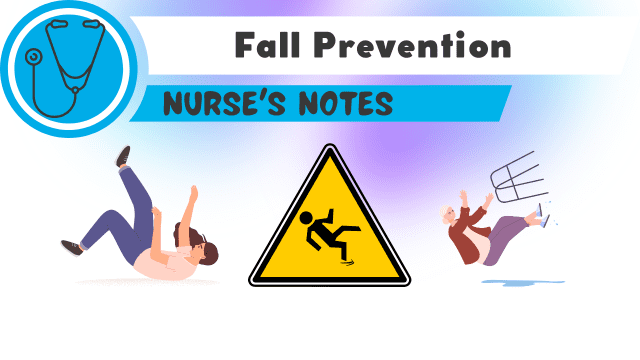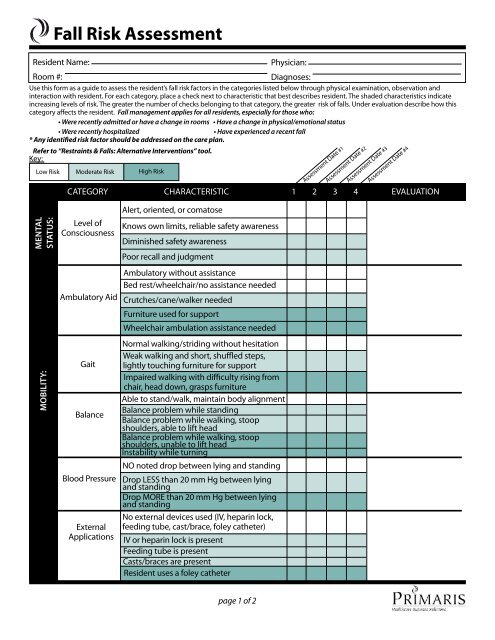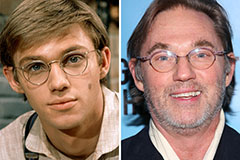The Definitive Guide for Dementia Fall Risk
Table of Contents10 Easy Facts About Dementia Fall Risk DescribedGetting The Dementia Fall Risk To WorkWhat Does Dementia Fall Risk Do?Not known Details About Dementia Fall Risk The Dementia Fall Risk Diaries
The FRAT has 3 areas: fall risk condition, danger variable list, and action plan. An Autumn Danger Standing consists of data about history of recent drops, drugs, emotional and cognitive standing of the patient - Dementia Fall Risk.If the individual ratings on a threat variable, the equivalent variety of factors are counted to the patient's fall risk score in the box to the far best. If an individual's loss threat score totals 5 or greater, the individual is at high danger for falls. If the client ratings just four factors or lower, they are still at some risk of dropping, and the nurse should use their finest medical assessment to manage all fall threat elements as part of a holistic care plan.
These standard approaches, in basic, assist establish a safe environment that decreases unintentional falls and marks core preventative steps for all individuals. Signs are important for patients in danger for falls. Doctor need to acknowledge that has the problem, for they are responsible for carrying out activities to advertise person safety and prevent drops.
Dementia Fall Risk for Beginners
Wristbands ought to include the client's last and first name, date of birth, and NHS number in the UK. Just red shade needs to be made use of to signify unique client status.
Items that are too much might need the client to reach out or ambulate unnecessarily and can possibly be a threat or add to falls. Helps prevent the person from heading out of bed with no support. Nurses react to fallers' telephone call lights quicker than they do to lights initiated by non-fallers.
Aesthetic disability can considerably trigger drops. Hip pads, when worn correctly, may lower a hip fracture when fall takes place. Keeping the beds closer to the floor lowers the danger of falls and significant injury. Putting the mattress on the flooring considerably reduces loss risk in some medical care setups. Reduced beds are created to reduce the range a client drops after moving out of bed.
How Dementia Fall Risk can Save You Time, Stress, and Money.
Individuals that are high and with weak leg muscles who try to rest on the bed from a standing position are likely to fall onto the bed since it's also reduced for them to decrease themselves safely. If a tall individual efforts to obtain up from a low bed without support, the person is likely to drop back down onto the bed or miss the bed and fall onto the flooring.
They're click here for info developed to advertise prompt rescue, not to stop falls from bed. Apart from bed alarm systems, raised supervision for high-risk people additionally might assist stop drops.

People with an evasion gait increase loss possibilities dramatically. To lower autumn threat, shoes must be with a little to no heel, thin soles with slip-resistant step, and sustain the ankles. Encourage client to make use of nonskid socks to stop the feet from moving upon standing. Motivate patients to wear ideal, well-fitting shoesnot nonskid socks for ambulation.
Some Known Details About Dementia Fall Risk
Clients, specifically older adults, have actually minimized visual capability. Illumination an unknown atmosphere helps increase exposure if the individual have to stand up during the night. In a research study, homes with adequate lights report less drops (Ramulu et al., 2021). Enhancement in illumination in the house may lower autumn prices in older adults (Dementia Fall Risk). The use of stride belts by all healthcare service providers can advertise safety when assisting patients with transfers from bed to chair.

Sitters work for guaranteeing a safe and secure, protected, and risk-free setting. Studies demonstrated extremely low-certainty evidence that caretakers minimize autumn threat in acute care medical facilities and just moderate-certainty that choices like video clip monitoring can minimize sitter usage without enhancing fall risk, suggesting that sitters are not as useful as initially thought (Greely more helpful hints et al., 2020).
The 30-Second Trick For Dementia Fall Risk

Raised physical conditioning minimizes the risk for drops and limits injury that is sustained when loss takes place. Land and water-based exercise programs may be in a similar way beneficial on balance and gait and thereby reduce the risk for drops. Water exercise might add a positive advantage on balance and stride for women 65 years and older.
Chair Rise Workout is a simple sit-to-stand workout that aids reinforce the muscle mass in the upper legs and butts and boosts flexibility and self-reliance. The goal is to do Chair Increase workouts without making use of hands as the customer go to website comes to be stronger. See resources section for an in-depth direction on exactly how to execute Chair Rise workout.
 Michael Bower Then & Now!
Michael Bower Then & Now! Richard Thomas Then & Now!
Richard Thomas Then & Now! Lucy Lawless Then & Now!
Lucy Lawless Then & Now! Tina Louise Then & Now!
Tina Louise Then & Now! Jeri Ryan Then & Now!
Jeri Ryan Then & Now!